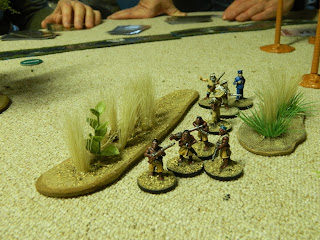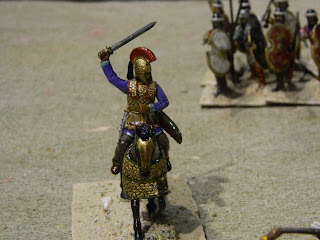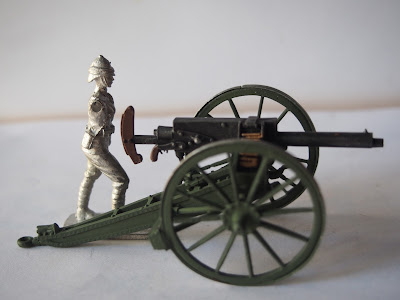2 games, 6 players, participating in each game
First game: Congo:
Luc presenting the game, having also painted the figures and made the scenery.
2 expediton players, 3 players for the indigenous warriors.
Each side having several groups:
expedition; Soldiers/ scouts/ adventurers /askaris/ suplement troops/special characters
Natives: bowmen/young warriors/fanatic warriors/ scouts/.special characters
Activation is with cards, that can be movement/ moral recovery/shooting, sometimes combined.
Each turn each side choses 3 cardswith different type of activation with diferent levels of initiative. Highest goes first.
Goal of our game was for the expedition to reach the fortified camp on the other side of the table.
The natives had to stop them.
Figthing/shooting results, end up with tookens and casualties.
Tokens can have different effects(loss in : movement/fighting/shooting/moral)
To have good effect of the rifles, we did send most of the expeditions groups to a large open space facing the bowmen group.
Seperated from the main expedition groups, the askaris, armed with muskets, were almost whiped out by the young warriors.
The bowmen were outgunned. The fanatic warrios came in for a charge but, they too were not strong enough to make a difference . Both native groups reduced to a figure, no longer able to stop the expedition.
second game:WWI Fighter Plane 1915
Our club member, Adrien, inspired by Wings Of War, painted over 50 WWI planes and made a rule for dogfights.
One of his inovations is using different (12) levels of altitudes.
Fighters can only shoot at planes on the same level, or one difference.
Tail gunners can shoot up to 3 levels higher, one down.
3 different movments per turn, noted on a sheet, together with the level changes.
At the end of the 3 movements positions can result in planes targating each other.
The game ends after 10 turns.
The German team was able to inflict 10 casualty points, the allies 9. No planes were shot down.
Narrow german victory




















































